
Kalsilite (KAlSiO4) is a vitreous white to grey feldspathoidal mineral that is found in some potassium-rich lavas, such as from Chamengo Crater in Uganda. It has a relative hardness of 5.5.

Abernathyite is a mineral with formula K(UO2)(AsO4)·3H2O. The mineral is named after Jesse Evrett Abernathy (1913–1963) who first noted it in 1953 in the U.S. State of Utah. It was described as a new mineral species in 1956. Abernathyite is yellow and occurs as small crystals.
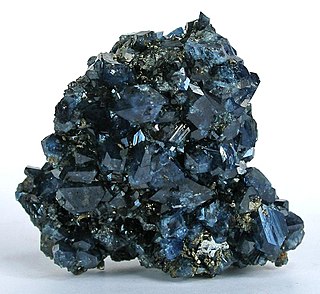
Scorodite is a common hydrated iron arsenate mineral, with the chemical formula FeAsO4·2H2O. It is found in hydrothermal deposits and as a secondary mineral in gossans worldwide. Scorodite weathers to limonite.

Calderite is a mineral in the garnet group with the chemical formula (Mn2+, Ca)3(Fe3+, Al)2(SiO4)3.
Geigerite is a mineral, a complex hydrous manganese arsenate with formula: Mn5(AsO3OH)2(AsO4)2·10H2O. It forms triclinic pinacoidal, vitreous, colorless to red to brown crystals. It has a Mohs hardness of 3 and a specific gravity of 3.05.
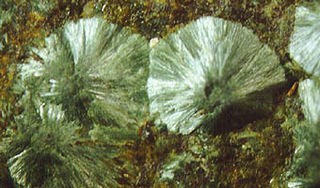
Pumpellyite is a group of closely related sorosilicate minerals:

Fornacite is a rare lead, copper chromate arsenate hydroxide mineral with the formula: Pb2Cu(CrO4)(AsO4)(OH). It forms a series with the phosphate mineral vauquelinite. It forms variably green to yellow, translucent to transparent crystals in the monoclinic – prismatic crystal system. It has a Mohs hardness of 2.3 and a specific gravity of 6.27.
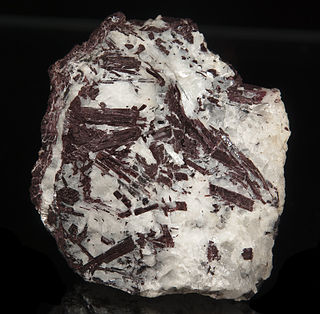
Piemontite is a sorosilicate mineral in the monoclinic crystal system with the chemical formula Ca2(Al,Mn3+,Fe3+)3(SiO4)(Si2O7)O(OH). It is a member of the epidote group.

Hafnon is a hafnium nesosilicate mineral, chemical formula (Hf,Zr)SiO4 or (Hf,Zr,Th,U,Y)SiO4. In natural zircon ZrSiO4 part of the zirconium is replaced by the very similar hafnium and so natural zircon is never pure ZrSiO4. A zircon with 100% hafnium substitution can be made synthetically and is hafnon.

Conichalcite, CaCu(AsO4)(OH), is a relatively common arsenate mineral related to duftite (PbCu(AsO4)(OH)). It is green, often botryoidal, and occurs in the oxidation zone of some metal deposits. It occurs with limonite, malachite, beudantite, adamite, cuproadamite, olivenite and smithsonite.

Alleghanyite is a moderately rare humite mineral with formula Mn5(SiO4)2(OH)2, belonging to the nesosilicates class. In general its occurrences are related with metamorphic (metamorphosed) manganese deposits. The mineral is named after Alleghany County, North Carolina, US.
Almarudite is an extremely rare alkaline manganese beryllium silicate mineral of the cyclosilicates class, with the chemical formula K([ ],Na)2(Mn2+,Fe2+,Mg)2(Be,Al)3[Si12O30], from the volcanic environment of the Eifel Mountains in Germany.

Iranite (Persian: ایرانیت) is a triclinic lead copper chromate silicate mineral with formula Pb10Cu(CrO4)6(SiO4)2(F,OH)2. It was first described from an occurrence in Iran. It is the copper analogue of hemihedrite (Pb10Zn(CrO4)6(SiO4)2(F,OH)2).
Larnite is a calcium silicate mineral with the formula Ca2SiO4. It is the calcium member of the olivine group of minerals.
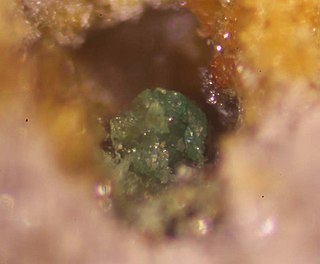
Tripuhyite is an iron antimonate mineral with composition FeSbO4.

Strashimirite is a rare monoclinic mineral containing arsenic, copper, hydrogen, and oxygen. It has the chemical formula Cu8(AsO4)4(OH)4·5(H2O).

Ferrimolybdite is a hydrous iron molybdate mineral with formula: Fe3+2(MoO4)3·8(H2O) or Fe3+2(MoO4)3·n(H2O). It forms coatings and radial aggregates of soft yellow needles which crystallize in the orthorhombic system.

Tlalocite is a rare and complex tellurate mineral with the formula Cu10Zn6(TeO4)2(TeO3)(OH)25Cl · 27 H2O. It has a Mohs hardness of 1, and a cyan color. It was named after Tlaloc, the Aztec god of rain, in allusion to the high amount of water contained within the crystal structure. It is not to be confused with quetzalcoatlite, which often looks similar in color and habit.
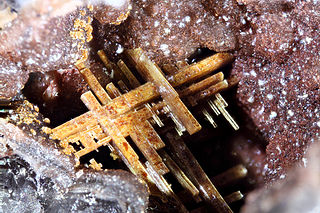
Arsenuranospathite (IMA symbol: Aush) is a rare mineral with the chemical formula Al(UO2)2(AsO4)2F·20H2O. The name "arsenuranospathite" as arsenate analog of uranospathite was first used by Walenta (1963) with reference to a uranyl-arsenate mineral from Black Forest (Schwarzwald) massif, Germany.

Arhbarite (IMA symbol: Arh) is a copper magnesium arsenate mineral with the chemical formula Cu2Mg(AsO4)(OH)3. It is named after its type locality, the Arhbar mine in Ouarzazate Province in Drâa-Tafilalet, Morocco.

















